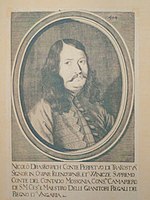Drašković (noble family)
| Drašković | |
|---|---|
| Country | Croatia |
| Parent company | Kršelac |
| founding | 16th Century |
| Ethnicity | Croatian |
| title | Barons, counts |
| Appointments | Bane of Croatia |
| founder | Bartol Drašković |
| Current chief | Dr. Karl Count Drašković |
Aristocratic family Drašković (French Draskovich or German Draschkowitsch ) is an old Croatian noble family that was powerful and influential in Croatia during the Habsburg monarchy .
historical overview
According to available sources, the noble family descended from a medieval Croatian tribe called Kršelac, who were not among the twelve privileged tribes. Its chiefs took part in the Croatian-Hungarian treaty Pacta conventa in 1102 as a contractual partner of King Koloman . The tribe belonged to the lower nobility of the Lika region .
Until the 15th century there is no reliable information about the members of the sex. It was not until 1490 that the three documents stored in the Hungarian State Archives in Budapest name “the 35 noble people of the Drašković family”. A document from 1520 named "Bartol Drašković von Knin " (German: Bartholomäus) as the founder of the later aristocratic branch of the sex.
Because of the great danger of constant Turkish attacks on the Lika, Bartol Drašković moved with his family to the northwestern Croatian region of Pokuplje (near Karlovac ) and strengthened his position there with marital ties. He had three sons: Georg (Croat. Juraj ), the Ban of Croatia, Bishop of Zagreb, Fünfkirchen and Raab, Archbishop of Kalocsa and Cardinal, then Kaspar (Croat. Gašpar ), who in 1567 was given the title " Freiherr (Baron)" and in 1569 the Trakošćan Castle received from the Croatian-Hungarian King Maximilian , and Johann (Croat. Ivan ), who fell as a military commander in 1566 during the Battle of Szigetvar .
The aristocratic family Drašković achieved its further rise and prosperity in the time of Kaspar's sons John II ( Ban of Croatia 1596–1608) and Peter , as well as his grandsons John III. (Ban of Croatia 1640–1646, Hungarian palatine 1646–1648). In 1631 the family received the title of " Count " from the Croatian-Hungarian King Ferdinand II .
In the course of the 17th, 18th and 19th centuries, the members of the noble family performed many church, military and state functions; they were bishops , archbishops and cardinals , generals and sub- marshals as well as royal chancellors , court advisers and judges . They were both famous generals in the wars against the Ottomans , as well as writers and great patrons of art and culture. They owned a lot of land , castles , manors and palaces not only in Croatia, but in the entire Habsburg monarchy of that time .

Todays situation
Of the once numerous branches of the Drašković family, only a few representatives have survived today.
The descendant of General Josef Kasimir Drašković's son Dr. Karl Graf Drašković (Draskovich), who had lost all his fortune in Croatia in 1945 and had lived in Austria for years, returned to his old property in Veliki Bukovec near Ludbreg in northern Croatia in 1992, together with his son Nikolaus, and started farming.
The successors of the second remaining branch of the family live in Hungary today ; the Budapest-born brothers Karl (* 1968), Georg (* 1970) and Peter (* 1971) descend from Karl I. Drašković (1807–1855), the owner of Bisag Castle in the Varaždin County (Northern Croatia).
Known members of the noble family
- Bartolomäus Drašković "von Knin" († 1538)
- Georg (1515–1587), Bishop, Cardinal and Ban of Croatia 1567–1576
- Kaspar (1530–1591), received in 1567 the title of " Freiherr (Baron)" and in 1569 the Trakošćan Castle
- Johann I (*? –1566), military commander in the battle of Szigetvar
- John II (1550–1613), Kaspar's son, Ban of Croatia 1596–1608
- Johann III. (1595 or 1603–1648), son of Johann II, Ban of Croatia 1640–1646, Hungarian palatine 1646–1648, received the title " Count " in 1631
- George III (1599–1650), son of Johann II, Bishop of Fünfkirchen 1628–1630
- Johann V. Anton (1660–1733), grandson of Johann III., Ban of Croatia 1732–1733
- Josef Kasimir (1714 or 1716–1765), son of Johann V Anton, general and sub-marshal of the Austrian Imperial Army
- Hannes (Jann) (1770–1856), grandson of Josef Kasimir, Croatian scholar, reformer and politician
- Georg V (1803 or 1804–1889), son of Josef and great-grandson of Josef Kasimir, general and sub-marshal of the Austrian Imperial Army
- Maria Countess Drašković von Trakošćan (1904–1969), daughter of Count Dionys Drašković von Trakošćan and Princess Julia von Montenuovo, married Albrecht Prince of Bavaria on September 3, 1930 , from 1955 to 1996 head of the House of Wittelsbach
photos
|
Georg / Juraj II / (1515–1587) |
Johann III. / Ivan III / (1595? –1648) |
Nicholas II / Nikola II / (1625? –1687) |
Johann V. Anton / Ivan V. / (1660–1733) |
Hannes (Jann) / Janko / (1770-1856) |
See also
- List of Bane of Croatia
- History of Croatia
- Croatia in the Danube Monarchy
- List of Croatian noble families
literature
- Ernst Heinrich Kneschke : German count houses of the present: in heraldic, historical and genealogical relation , Volume 3, Leipzig 1854, p. 87f digitized
- Constantin von Wurzbach : Draškovič, the family (in the article by Janko Draškovič) . In: Biographisches Lexikon des Kaiserthums Oesterreich . 3rd part. Typogr.-literar.-artist publishing house. Establishment (L. C. Zamarski, C. Dittmarsch & Comp.), Vienna 1858, p. 377 f. ( Digitized version ).
Web links
- Tribe list of the Drašković family , 2
- Short biographies of some members of the aristocratic family ( memento from June 10, 2007 in the Internet Archive )






